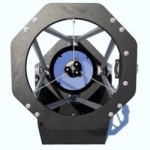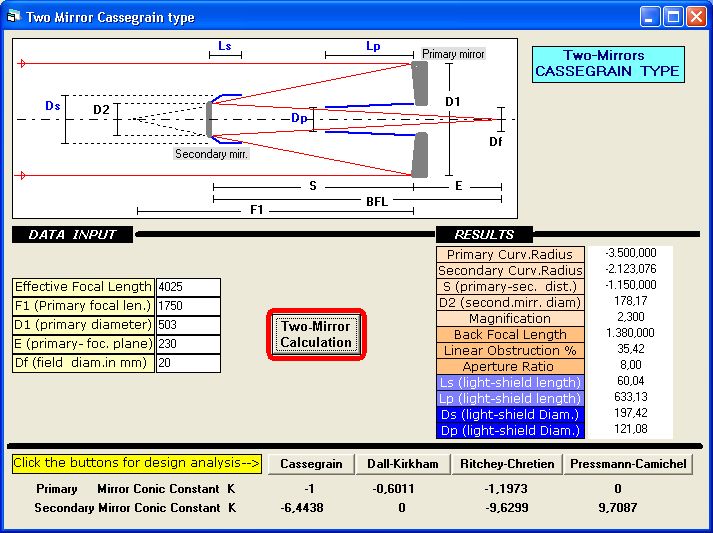- This topic has 9 replies, 2 voices, and was last updated 6 years, 3 months ago by
 Massimo Marconi.
Massimo Marconi.
-
AuthorPosts
-
9 December 2017 at 12:37 #10634
Hi everyone,
It is my first post on this forum, first of all congratulations for the idea and for the site very well equipped with technical articles.I need to know how to accurately calculate the length of the lens hood that must be affixed to the primary mirror of a RC. I refer in particular to an RC 500 mm f/8.
Thank you
Antonino9 December 2017 at 12:58 #10635Hello and welcome Antonino !
to calculate the diameter and length of the lens hood is necessary to know other data relating to the optical scheme:
-focal length of the primary
-Backfocus
-CPL (field full light )these data, together in diameter and overall focal, They can be used with any of optical design software, for example ATMOS available in the demo version (free) in our pages download
After installing the software you can access the preset configurations of the Cassegrain and enter the relevant data, at that point Atmos may calculate all of the missing data for a RC configuration:
-diameter and focal secondary
-distance between the mirrors
-conical constant of the mirrors
-primary lens hood
-Secondary lens hoodYou can then try installing the software, or, if you prefer, We send us the missing data and calculate the lens hood
 9 December 2017 at 15:32 #10638
9 December 2017 at 15:32 #10638Thank you for your prompt response.
Unfortunately I do not find the required data as the manufacturer of the mirror is not provided me with its datasheets.
Since I'm trying to optimize the system because I think there are several errors, both optical and mechanical to be corrected, I am now stuck. How I could rtovare the effective focal both the primary mirror and secondary? 9 December 2017 at 17:56 #10639
9 December 2017 at 17:56 #10639Mah… I also would try to ask the builder, as the optimization of the optical RC is linked to the construction parameters that only the designer knows exactly.
For example, a small displacement also one-two mm from the correct distance between the primary and secondary can cause, as well as a variation of the overall focal length of some cm, a spherical aberration ( otherwise nonexistent ) which would lead to think that the optics are faulty.
The basic parameters to be known x optimize the whole system are:
-distance between the mirrors (You can, however, derive primary knowing F, F complessivo e Back-focus )
-back-focus
-Cpl
-The focal length of the primary It can be measured directly as you would with a parabolic mirror, hyperbole because the deviation from the primary reference parable is really small . Generally, the focus of the primary is outside the optical tube and can also be measured with ease without removing the mirror from the telescope. the limits, if you do not want to make a measurement off-axis, it would be convenient to remove all the support of the secondary before carrying out the test.
– The focal length of the secondary however, it can not be measured directly, and also the value of the hyperbolic conic constant is of a higher order of magnitude to the primary and the difference on the focal plane ( negative ) You are felt all right ! However for the purposes of optimization of the system and the calculation of the hood, the secondary values may also remain unknown ( assuming that the optical is correct ), They are sufficient values of the back-focus and the distance between the mirrors, at that point there is only a hyperbole of the secondary verification that this specific configuration, and then the respective parameters are deduced analytically, although we hardly needed to use them, just in case we were to notice that the resulting system is not correct.19 December 2017 at 19:22 #10647Hi Massimo,
the data I have known at the time of the system are as follows:mirror Diameter: 510 mm
Diameter Secondary Mirror: 178 mm
Hole diameter primary mirror: 114 mm
Distance between primary and secondary: 1150 mm
primary hood Length: 350 mm
Primary hood diameter: 80 mm
Secondary hood Length: 95 mm
Secondary hood diameter: me 178 mm max 194 mm
Backfocus: 150 mmI wonder what you think about and if it is possible to extract useful data to optimize the system.
Thank you19 December 2017 at 21:32 #10648hello Antonino, I confirm the Back-focus 150 mm? this measure should be understood from the center of the mirror ( from the reflective ) to the focal plane.
19 December 2017 at 23:26 #10649If the back focus we mean by the center of the mirror is 230 mm
20 December 2017 at 12:48 #10650You can groped a simulation to reconstruct the original scheme which, however, will not provide any guarantee to match the telescope in question, for two main reasons:
1- at least one of the two optics should be constant and known for focal conic.
2- the distance between the mirrors is of course that measured, but it is said that it is the project that is the correct and necessary. The telescope will definitely have a longitudinal adjustment system to vary the position of the secondary along that axis. If the current of the secondary position was different ( Also very little ) from design, then also this parameter would be unknown and there are infinite configurations that can verify the schema.
An important indication of the real goodness and optimization of the whole system could come from a star-test.
Having said that we try equally to hypothesize a possible RC scheme with the data available to have an estimate of the size deil hood.
in this simulation, the primary diameter has been reduced to 503 mm whereas there will surely be a chamfer at the edge of the non-reflecting mirror.
Let us then an RC schema that returns the values known to us :
To say that this is the original design would be like betting lottery, however, the system should not differ much from this hypothesis, we will definitely optimize everything with these data, but we can make an assessment on the primary lens hood, the object of our investigation, which should be longer ( and consequently wider ) to ensure that the cone of light seen from the back focus is fully protected from external reflections.
Obviously this applies whether we are talking of a telescope “open” with a lattice intubation, It would be different for a closed tube in which the lens hood of the primary may not be necessary and in any case not in these dimensions.
It is interesting to see that, to obtain this distance between the mirrors, with this back-focus, the primary should be a F3.5
22 December 2017 at 18:58 #10652Hi Massimo,
first of all thank you for the precise and complete clarification.
My RC is not a lattice model but it is a closed tube, So now I ask, definitely would agree to remove the lens hood? This I ask because in the flat I have a strange vignetting that I can not solve and the last resort is just the hood. In the flat you see a black hole at the center and the edges of all white. Obviously I worked to rule out other causes, and none of the solutions has therefore worked my doubt focused on the lens hood.
Thank you
Antonino27 December 2017 at 12:54 #10654hello Antonino, It is difficult to answer without knowing the telescope in question, I think it has been designed and built with the hood dimensioned that way have had their own reasons. Besides, I am not an expert and photographic techniques I could not guess what would be the influence of changes to the hood.
What is certain that the hood acts mainly on two aspects:
– protection from external sources / reflections to the optical cone
– the size of the field of full light, beyond which begins the vignetting and the consequent decrease in brightness on the focal plane. By removing the lens hood the CPL would be limited by the size of the secondary ( usually it made larger than necessary to avoid having to use the critical zone of the edge, hidden just by the hood ) and the central hole on the primary, consequently would increase the full-brightness area on the focal plane and at this point come into play the size of the sensor used for the acquisitions, which might be such as to be affected by the change of setup.therefore, if you've already ruled out other possible causes, an attempt to capture without a hood I would, if only to see if and how to evolve the malfunction you're experiencing.
-
AuthorPosts
- You must be logged in to reply to this topic.